- 翰林提供学术活动、国际课程、科研项目一站式留学背景提升服务!
- 400 888 0080
AP宏观经济| 知识点全面梳理
经济学的基础是经济现象,首先它是描述现象,然后再通过抽象这些现象以找出它们的共同点,进而解释它们产生的原因。因此,经济学入门的第一步就是要知道这个学科是如何来描述它所要研究的现象的。以下文字摘自AP宏观经济学大纲,这是大纲的第一部分,标红处就是最基本的经济现象抽象成一个个学科术语,我们就从这里入手。
I. Basic economic ConceptsI.Basic economic concepts (8–12%)
A. Scarcity, choice and opportunity costs 稀缺性、选择和机会成本
B. Production possibilities curve 生产可能性曲线
C. Comparative advantage, absolute advantage,specialization and exchange 比较优势,分工,交换
D.Demand, supply and market equilibrium 需求,供给,市场均衡
E. Macroeconomic issues: business cycle,unemployment, inflation, growth 经济周期,失业,通货膨胀,增长
A macroeconomics course introducesstudents to fundamental economic concepts such as scarcity and opportunity costs. Students understandthe distinction between absolute and comparativeadvantage and apply the principle of comparative advantage to determinethe basis on which mutually advantageous trade can take place betweenindividuals and/or countries and to identify comparative advantage fromdifferences in opportunity costs. Other basic concepts that are exploredinclude the functions performed by an economic system and the way the tools of supplyand demand are used to analyze the workings of a free-market economy. The course shouldalso introduce the concept of the business cycle to give students an overview of economic fluctuations and to highlight the dynamics of unemployment,inflation and economic growth. Coverage of these concepts providesstudents with the foundation for a thorough understanding of macroeconomicconcepts and issues.
这一章是宏观经济学的基础,opportunity cost、production possibilitiescurve、advantage是必考点,每年至少一道选择题。Demand,supply and market equilibrium也是必考,而且它的分量要比前面三个知识点更重。
scarcity稀缺性稀缺性是用来描述资源的,这里的资源包括很多内容,比如生产商品的原材料、劳动力、时间等等,一个广泛流传的关于经济学的定义就是——经济学是研究稀缺资源配置的学问。可以说如果没有资源的稀缺性,就没有经济学这个学科。
那么,为什么资源是稀缺的?这里可以给出很多种解释,常见的解释是地球上可获得的资源量是有限的,从木材到土地、从苹果到电脑,这些东西都是有限的。这是一个绝对意义上的解释,但稀缺性还包含另外一方面的意思,即资源的有限性是相对于人类欲望的无限性来说的,意思就是,不论资源有多少,人类的欲望总要比这个有限的资源多。 opportunity costs
机会成本稀缺性是经济学的基础,由稀缺性衍生出一系列经济学的概念,机会成本是第一个。
机会成本是说,当一种资源用在一个地方之后,它就不能用在另一个地方(为什么?因为资源是稀缺的,你只有这么一点点资源,所以只能用在一个地方,如果资源不是稀缺的,意味着你拥有很多很多,那么就不会在乎用在这里或那里了,因为永远用不完!),这样就会有一个损失,失去了用在其他地方的机会(获益的机会),机会成本正是由此而来,它表示你所放弃的最高的价值。举个例子,你有100元钱,存到银行会得到利息5元,去投资买房子,会获利20元,放高利贷,获利50元,对比一下,你自然会选择去放高利贷,那么,放高利贷的机会成本是多少呢?100元放了高利贷,就不能存银行,也不能买房子,它们俩的利润是5和20,选择其中最高的20(因为5和20并不能同时获得,所以不可以相加得到25),因此,放高利贷的机会成本是20元。
absolute and comparativeadvantage
绝对比较优势和相对比较优势我们用一个例子来说明这个概念。现在有三个人,甲、乙、丙,甲一天能煮出100锅饭、100件衣服,乙一天能煮出80锅饭、做出20件衣服,丙一天能做出20件衣服、煮出10锅饭。这样,在煮饭和做衣服这两个项目上,甲强势压过乙和丙,具有绝对比较优势(因为煮饭100>80>20,做衣服100>20>10),去掉甲,乙又超丙,乙又具有绝对比较优势。
但是我们能不能说丙就一无是处了呢?不是,我们再看,甲煮饭和做衣服数量比是1:1,乙是4:1,丙是2:1,比较乙和丙,同样做一件衣服,乙的成本是4锅饭,丙是2锅饭,虽然在绝对数量上丙落后,但是在相对意义上(比例上),丙做衣服的成本要低于乙,因此,丙在做衣服上与乙相比具有相对比较优势。如果乙和丙相互不认识,那么他们所能够生产的最大值(假设他们各用半天时间煮饭和做衣服)40 +5=45锅饭,10+10=20件衣服,但是如果两个人认识,决定共同生产,甲专门煮饭,乙专门做衣服,那么就变成80锅饭和20件衣服。
在这里,生产资源并没有发生变化,仅仅由于两个人合作,使产量从45提高到80,这就是分工的好处,也是交易的好处,即是市场的好处。有了市场,人们可以专注于自己擅长的,然后在市场上交易,获得自己想要的东西,虽然资源量没有增加,但是产出量增加了,经济学也因此获得了关注。
Production possibilities curve
生产可能性曲线有一种资源,可以生产两种不同的产品,各种产品不同的组合所构成的曲线,就称为生产可能性曲线。沿用上面乙的情形,给乙100天的时间,他用x天煮饭,y天做衣服,那他能够提供的商品量是:饭rice=80x,衣服clothes=20y,但是x+y=100,代入后得到:rice/80+clothes/20=100,以横坐标为rice,纵坐标为clothes,画出这条曲线,就是乙的生产可能性曲线。
supply and demand
供给和需求在一个市场上,需要有商品的存在,提供商品的就是供给者,买走商品的就是需求者。一个人不可能生产所有自己所需要的东西,专业化分工可以提高福利,所以社会产生分工,由于分工的存在,商品分散在不同人的手中,这样他就需要用自己生产的去交换自己需求的,从而产生了市场,有了供给和需求。
在市场上,各种商品用价格标注,供给这种商品的人付出商品获得货币、需要这种商品的人付出货币获得商品。我们猜想,如果一种商品的价格很高很高,那么买它的人就会少,如果价格低,买的人就会多;同理,高价的东西也会有更多人去生产它,低价则不然。
给定一个价格,供给量和需求量不一定相等,但是,我们可以假定有这样一个价格的存在——它恰好是供给量等于需求量。这样市场上既不会有多余的商品卖不出去,也不会有人买不到他所需要的商品,此时供需相等,称市场达到均衡,这个价格称为均衡价格。business cycle, economicfluctuations
商业周期(经济周期),经济波动均衡的市场是美好的,但是美好的东西不一定存在的。
价格很可能高,那么就是供过于求,供过于求商品积压、滞销,这样价格就会下降,价格下降需求量就会增加,积压的商品一点点清空。价格低了,供不应求,就会有好多人抢着买,这样就会有人加入到这种商品的生产中来,从而供给量增加,商品多了,抢购的现象一点点消失,价格一点点下降。
因此,市场总会将价格拉到均衡的价格上来。经济就在这繁荣与萧条之间转换,交替出现,是一种周期现象,所以称为经济周期。供给和需求不停地变动,称作经济波动。 unemployment, inflationand economic growth
失业、通货膨胀、经济增长。首先,一个国家中并不是所有人都具备劳动能力,按照这个标准把一国的人口分成劳动人口和非劳动人口。
在劳动人口中,那些想工作但是没有工作的人就是失业者,失业人数占总劳动人口的比例就是失业率,它可以衡量社会中闲置劳动的比率。通货膨胀是说在某一段时期内,社会整体物价水平飙升,与通货膨胀相反的概念是通货紧缩,它是指在某一段时期内价格持续地下降。经济增长,指收入增加、生产的商品数量增多、人民生活水平提高。
II. Measurement of economic PerformanceII.Measurement of Economic Performance (12–16%)A. National income accounts 国民收入账户
1. Circular flow 循环
2. Gross domestic product 国民生产总值(GDP)
3. Components of gross domestic product 国民生产总值的构成
4. Real versus nominal gross domestic product 实际与名义GDPB. Inflation measurement and adjustment 通货膨胀
1. Price indices 价格指数
2. Nominal and real values 名义价格与实际价格
3. Costs of inflation 通货膨胀的(社会)成本
C. Unemployment 失业
1. Definition and measurement 定义和度量指标
2. Types of unemployment 失业的类型
3. Natural rate of unemployment 自然失业率
To provide an overview of how theeconomy works, the course should start with a model of the circular flow of income and products that contain the foursectors: households, businesses, government and international. It is importantto identify and examine the key measures of economic performance: gross domestic product, unemployment and inflation.
In studying the concept of gross domestic product, it is also importantthat students learn how gross domestic product is measured, have a clearunderstanding of its components and be able to distinguish between real and nominal gross domestic product.
The course should examine the nature and causes of unemployment, the costs of unemployment and how the unemployment rate is measured, including thecriticisms associated with the measurement of the unemployment rate. It is alsoimportant to understand the concept of the natural rateof unemployment and the factors that affect it. Students should alsohave an understanding of inflation and how it ismeasured. In this section, the course should cover the costs of inflation andthe main price indices, such as the consumer priceindex (CPI) and the gross domestic productdeflator. Students should learn how these indices are constructed andused to convert nominal values into real values, as well as to convert dollarvalues in the past to dollar values in the present. It is also important tohighlight the differences between the two price indices as a measure ofinflation, as well as the problems associated with each measure.
A
1.经济循环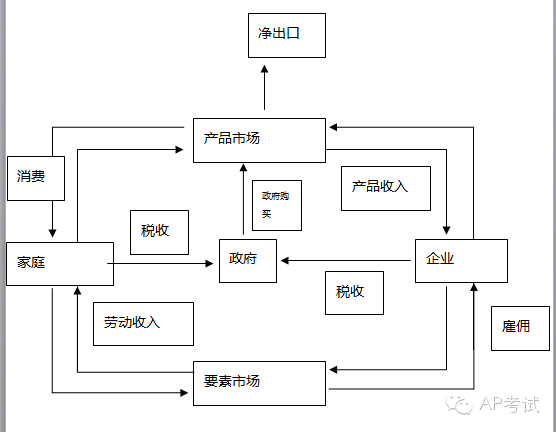
2、GrossDomestic Product(GDP)国内生产总值,它指在一定时期内(一个季度或一年),一个国家或地区的经济中所生产出的全部最终产品和劳务的价值。有以下几点需要注意,第一,GDP是一个时间段内的概念,谈GDP首先必须指明一个时间跨度,比如从去年的今天到今年的今天,这是整整一年。
第二,GDP是在这一时间段中一个国家或地区,所新生产出的最终产品和劳务的总和,只有最终的才计算在GDP里面,中间产品不算。用公式表示出来就是:GDP=ΣPX。
3、GDP的构成由上面的经济循环流程图我们看到,经济中一共有四个主要的部分:居民、企业、政府和国际贸易,对应于此,GDP包括这四个经济指标,分别为:消费、投资、政府购买和净出口,用公式表示Y=C+I+G+NX。
4、实际与名义GDP当价格用规定的之前某一年的价格(称为基期价格)时,称其为实际GDP;当计算GDP中的价格P用现在的市场价格时,所得到的GDP称为名义GDP。
实际与名义的区别在于前者剔除了价格变动的影响,后者则将其包括在内。名义GDP与实际GDP的比值称为GDP平减指数(GDP deflator)。
B
1、通货膨胀当价格呈现长期、普遍上涨的时候,我们称为通货膨胀;当价格呈现长期、普遍下降的时候,我们称为通货紧缩。注意的地方是,通货膨胀和通货紧缩是描述价格长期的、普遍的变化趋势,并不单单指某一产品。如果仅仅是某一产品,我们只能说它的价格上涨了,却不能说发生通货膨胀了。
2、消费者价格指数(CPI)我们把产出中和我们日常生活息息相关的产品找出来,对他们的价格进行记录,即固定商品、改变价格,用后一年(或一个月、一个季度)的数值除以前一个数值,得到的比值称为CPI。
与GDP平减指数不同,CPI反应与居民生活密切相关的那些商品的价格变动,而GDP平减指数衡量经济中所有产品的价格变动。
3、通货膨胀的成本鞋底成本:shoe-leather cost,通货膨胀使人们不愿持有货币,这样,当需要消费的时候,人们就要一次又一次地去银行取钱,如此损失掉的时间与便利称为鞋底成本。当然它不单单只磨坏鞋底所遭受的损失,更重要的是表示通货膨胀使人们损失掉了时间与便利。
菜单成本:menu cost,这个词源自餐馆印刷新菜单的成本,它包括决定新价格的成本、印刷新清单和目录的成本、把这些新价格表和目录送给中间商和顾客的成本、为新价格做广告的成本,甚至包括处理顾客对价格变动恼怒的成本。
C
1、失业设L代表社会中所有的劳动人口数,E代表就业人数,U代表失业人数,则L=E+U,失业率为U/L。劳动力市场均衡时的失业率称为自然失业率,它总是存在的(即自然失业率大于零,经济中总会有人失业)。
如下图所示:劳动力市场均衡时,均衡工资是W0,均衡就业人数是Ne,经济中总的劳动人口数是N,这样就有N-Ne这么多人失业,(N-Ne)/N就是自然失业率。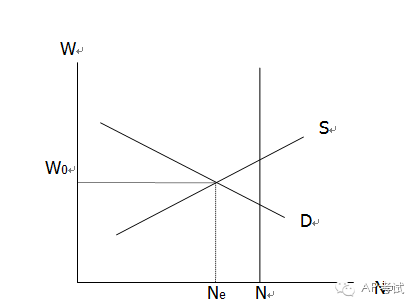
2、失业的分类结构性失业:指劳动力的供给和需求不匹配所造成的失业,其特点是既有失业又有职位空缺。失业的原因是失业者或者没有合适的技能,或者居住地与工作地相距甚远,导致其不愿意工作。季节性失业:指某些生产活动受季节性影响而导致的失业,比如农业,当冬季来临时,普遍都无事可做。
周期性失业:指经济周期中的衰退或萧条时,因需求下降而造成的失业。摩擦性失业:指在生产过程中由于难以避免的摩擦而造成的短期、局部性失业,比如人们换工作时,先辞职却没有找到新的工作,这样就会有一段时间失业,这个就是摩擦性失业。
III.National Income and Price determination III. National Income and Price Determination (10–15%)
A. Aggregate demand 总需求
1.Determinants of aggregate demand 总需求的决定
2.Multiplier and crowding-out effects 乘数效应与挤出效应
B. Aggregate supply 总供给
1.Short-run and long-run analyses 短期与长期分析
2.Sticky versus flexible wages and prices 工资与价格的黏性与自由伸缩性
3.Determinants of aggregate supply 总供给的决定
C.Macroeconomic equilibrium 宏观经济均衡
1.Real output and price level 实际产出与价格水平
2.Short and long run 短期与长期
3.Actual versus full-employment output 实际产出与充分就业产出
4.Economic fluctuations 经济波动
This section introduces the aggregate supply and aggregatedemand model to explain the determination of equilibrium national output andthe general price level, as well as to analyze and evaluate the effects ofpublic policy. It is important to discuss the aggregatedemand and aggregate supply concepts individually to provide studentswith a firm understanding of the mechanics of the aggregate demand andaggregate supply model.
The aggregatedemand and aggregate supply analysis often begins with a general discussion ofthe nature and shape of the aggregate demand and aggregate supply curves andthe factors that affect them. A detailed study of aggregate demand may begin bydefining the four components of aggregate demand: consumption,investment, government spending and net exports. It also examines whythe aggregate demand curve slopes downward and how changes in the determinantsaffect the aggregate demand curve. The spending-multiplierconcept and its impact on aggregate demand, and how crowdingout lessens this impact, should be demonstrated as well. The course canthen present the definition and determinants of aggregate supply and thedifferent views about the shape of the aggregate supply curve in the short run and in the long runand highlight the importance of the shape in determining the effect of changesin aggregate demand on the economy. It is also important to understand thenotion of sticky-price and sticky-wage models and their implication for theaggregate supply curve in comparison to flexible pricesand wages.
Studentsshould be able to use the aggregate demand and aggregate supply model todetermine equilibrium income and price level and to analyze the impact of economicfluctuations on the economy’s output and price level, both in the short run andin the long run.
A
1.总需求总需求:它表示任何一种既定的物价水平下经济中所有物品和劳务的需求量。在现阶段大家可以参照需求曲线来记忆,即价格与需求量之间反向变动的关系。
总需求的构成:Y=C+I+G+NX,总需求由消费、投资、政府购买和净出口构成。影响总需求的因素:总需求Y=C+I+G+NX,可见,影响C、I、G、NX的因素都能够影响到总需求。消费受居民收入、利率影响,投资受利率影响,G是政府政策,NX受贸易政策、汇率影响。
2.乘数效应与挤出效应乘数效应:乘数有很多种,投资乘数、政府购买乘数、税收乘数等等,它们都是指一个变量发生变化后引起收入的变动与该变量变动量的比值。叙述有点绕,看公式,乘数=ΔY/ΔX,这里X可以代表上面说的变量。
挤出效应:指政府支出增加所引起的消费或投资降低这种现象。注意乘数效应与挤出效应的对比,同样是政府支出增加,一个会引起收入的多倍增长,从而消费增加,一个却导致消费下降。原因在于二者所基于的经济状况不同,乘数效应起作用时,经济中有大量闲置资源,政府支出的增加不会抬高资本市场的利率,从而不会导致投资降低。
而挤出效应是经济已经没有闲置资源,此时政府增加支出,必然会破坏资本市场的均衡,抬高利率,从而挤出投资。
B
总供给总供给:它表示任何一种既定的物价水平下经济中所有物品和劳务的供给量。短期和长期的不同:短期:总供给曲线向右上方倾斜,产量随价格变动长期:总供给曲线垂直,产量与价格无关工资与价格的黏性与自由伸缩性:对应于短期和长期,短期内工资与价格黏性(即变动缓慢甚至不变动),长期内自由伸缩(自由变动)。但同时,在短期内,凯恩斯学派认为工资与价格是黏性的,而古典学派认为它们是自由伸缩的,这是两个学派争论的焦点。总供给的决定
C
宏观经济均衡用下面这个图就可表示出C中提到的所有变量与现象。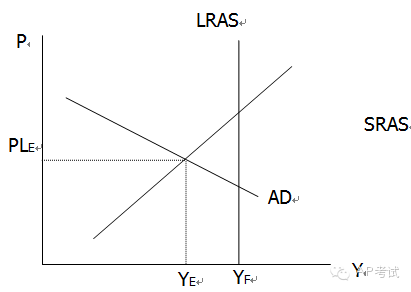 AD与SRAS相交处代表着短期均衡,所决定的产出YE就是短期实际产出和短期价格水平PLE;AD与LRAS相交处代表着长期均衡,产出固定在YF处不变,价格随意波动。
AD与SRAS相交处代表着短期均衡,所决定的产出YE就是短期实际产出和短期价格水平PLE;AD与LRAS相交处代表着长期均衡,产出固定在YF处不变,价格随意波动。
当AD或SRAS移动的时候,短期内会导致均衡产出的变动;LRAS的移动会导致长期均衡产出的变动,从而导致了经济增长或萧条。 IV.Financial sectorIV. Financial Sector (15–20%)A.Money, banking and financial markets 货币、银行与资本市场
1.Definition of financial assets: money, stocks, bonds 货币、股票与债券的定义
2.Time value of money (present and future value) 货币的时间价值
3.Measures of money supply 货币供给的度量
4.Banks and creation of money 银行与货币的创造
5.Money demand 货币需求
6.Money market 资本市场
7.Loanable funds market 可贷资金市场
B.Central bank and control of the money supply 中央银行和控制货币供给
1.Tools of central bank policy 政策工具
2.Quantity theory of money 货币数量论
3.Real versus nominal interest rates 实际与名义利率
Tounderstand how monetary policy works, students must understand the definitionsof both the money supply and money demand and the factors that affect each of them.Here the course introduces students to the definition of money and otherfinancial assets such as bonds and stocks, the time value of money, measures ofthe money supply, fractional reserve banking and the Federal Reserve System. Inpresenting the money supply, it is important to introduce the process ofmultiple-deposit expansion and money creation using T-accounts and the use ofthe money multiplier. In learning about monetary policy, it is important todefine money demand and examine its determinants. Having completed the study ofmoney supply and money demand, the course should proceed to investigate howequilibrium in the money market determines the equilibrium interest rate, howthe investment demand curve provides the link between changes in the interestrate and changes in aggregate demand, and how changes in aggregate demandaffect real output and price level. Students should have an understanding offinancial markets and the working of the loanable funds market in determiningthe real interest rate. It is also important that students develop a clearunderstanding of the differences between the money market and the loanablefunds market.
Having an understanding of the financialmarkets, students should identify and examine the tools of central bank policyand their impact on the money supply and interest rate. Students shouldunderstand the distinction between nominal and real interest rate. Studentsshould also be introduced to the quantity theory of money and examine andunderstand the effect of monetary policy on real output growth and inflation.
A1.货币、股票、债券货币:一种交换媒介,通过它使得物物交换的弊端得到克服,从而活跃了经济。股票(stock):代表企业所有权,进而可以索取企业的利润。债券(bond):是规定借款人对债券持有人负有债务责任的证明。
货币的时间价值:由于利率和通货膨胀的存在,货币即有收益又有成本。因为把钱存在银行,至少可以得到利息,但得到利息的同时会遭遇通货膨胀所导致的实际购买力的降低。因此未来的货币拿到现在需要经过换算——折现,公式为P0=Pt/![]() 。货币供给的度量:货币供给指是指某国银行系统向经济体中投入(或回笼)货币的过程。
。货币供给的度量:货币供给指是指某国银行系统向经济体中投入(或回笼)货币的过程。
一般来说,货币量=通货+活期存款+小额定期储蓄存款+大额定期存款。银行与货币的创造:当银行只把部分存款作为准备金时,账面数额加上贷款数额使得经济中货币的数额比原始发行的货币额多,此时称银行创造了货币,这个比值称为货币乘数。货币需求:D=L(i,Y),货币需求与利率呈反比,与收入呈正比。因此,当经济繁荣时,货币的需求会增加,此时中央银行需要发行货币,以满足市场对货币的需求。
资本市场:中央银行作为货币的供给方,公众及企业作为货币的需求方,由此形成的市场称为货币市场或资本市场。
可贷资金市场:以货币为商品交易的市场称为可贷资金市场。考虑储蓄和投资,居民储蓄与利率呈正比,企业投资与利率呈反比,这样可贷资金市场就可以用下图来表示。 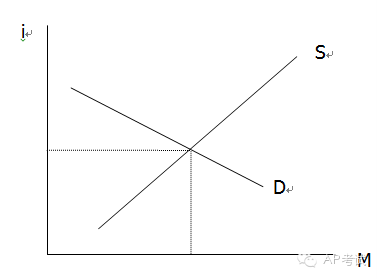
B1.政策工具中央银行控制货币供给的政策工具主要有三种:公开市场业务、法定准备率和贴现率。公开市场业务(open-marketoperations):指中央银行通过买卖政府债券来调节货币供给。当中央银行从公众手里购入债券时,公众持有的债券变成了货币,从而货币供给增加;反向就是减少货币供给。
法定准备金率(reserverequirements):指中央银行对商业银行存款准备金的规定,存款准备金比率上升会抑制可贷资金的数量,从而降低货币乘数,进而减少货币供给。再贴现率(discount rate):指中央银行向商业银行发放贷款时所收取的利率。货币数量论:MV=PY,货币数量M乘以货币流通速度V等于产品的价格P乘以产量,这个公式称为数量方程式。
当假设货币流通速度V不变时,P=MV/Y,价格与货币数量成正比,与产出Y成反比。实际与名义利率:把货币储存在银行里,一段时间之后得到利息,同时由于通货膨胀的存在,货币的实际购买力减少。我们把银行支付的利率称为名义利率i,则实际获得的利率是i-π,经过通货膨胀调整之后的利率称为实际利率r,它衡量了货币实际购买力的变动。
V. Inflation, unemployment, stabilization PoliciesV.Inflation, Unemployment, and Stabilization Policies (20–30%) 通货膨胀、失业与稳定政策
A. Fiscal and monetary policies 财政政策与货币政策
1. Demand-side effects 需求方
2. Supply-side effects 供给方
3. Policy mix 混合政策
4. Government deficits and debt 财政赤字与政府债务
B. Inflation and unemployment 通货膨胀与失业
1. Types of inflation 通货膨胀的类型(成因)
a. Demand-pull inflation 需求拉动型
b. Cost-push inflation 成本推动型
3. Role of expectations 期望(预期)的影响
Public policy affects the economy’s output, price level andlevel of employment, both in the short run and in the long run. Students shouldlearn to analyze the impacts of fiscal policy and monetary policy on aggregatedemand and aggregate supply, as well as on the economy’s output and price levelboth in the short run and in the long run. It is also important to understand howan economy responds to a short-run shock and adjusts to long-run equilibrium inthe absence of any public policy actions.
With both monetaryand fiscal policies now incorporated in the analysis of aggregate demand andaggregate supply, an understanding of the interactions between the two isessential. Students should also examine the economic effects of governmentbudget deficits, including crowding out; consider the issues involved indetermining the burden of the national debt; and explore the relationshipsbetween deficits, interest rates and inflation. The course should distinguishbetween the short-run and long-run impacts of monetary and fiscal policies andtrace the short-run and long-run effects of supply shocks. Short-run andlong-run Phillips curves are introduced to help students gain an understandingof the inflation–unemployment trade-off and how this trade-off may differ inthe short and long run.
In this section, the course identifies the causes ofinflation and illustrates them by using the aggregate demand and aggregatesupply model. A well-rounded course also includes an examination of thesignificance of expectations, including inflationary expectations.
A
1.财政政策与货币政策财政政策:指政府通过改变税收和政府支出来影响总需求,进而影响就业和国民收入的政策;货币政策:指中央银行通过调整经济中的货币量来影响就业和国民收入的政策,常用的是改变利率。
税收政策的调整会影响到需求方和供给方,如对个人所得税税率的调整直接影响居民的可支配收入,从而改变居民的消费支出,改变了总需求;对企业所得税税率的调整影响到企业收益,从而影响企业投资的积极性,改变了企业的投资。
利率的调整也是如此,对居民消费方面利率会改变货币的时间价值,从而居民的消费发生跨期替代,当期的消费会发生变化;对企业则是直接影响到企业投资成本,从而企业改变投资决策。
2.财政赤字与政府债务政府收益减去政府支出所得就是财政赤字(当收益小于支出时),或财政盈余(当收益大于支出时)。
政府为了平衡预算,消除财政赤字,会向私人部门借款,这就是政府债务。
B1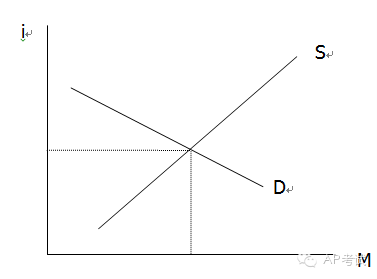 在总供给不变的情况下,当总需求增加之后,会拉动价格水平上升,这种方式导致的通货膨胀称为需求拉动型通货膨胀。
在总供给不变的情况下,当总需求增加之后,会拉动价格水平上升,这种方式导致的通货膨胀称为需求拉动型通货膨胀。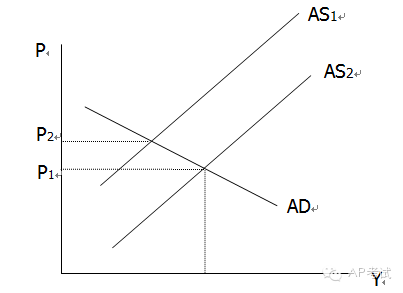 在总需求不变的情况下,当生产成本上升,会导致总供给减少,此时会推动价格水平上升,这种方式导致的通货膨胀成为成本推动型通货膨胀。2.菲利普斯曲线
在总需求不变的情况下,当生产成本上升,会导致总供给减少,此时会推动价格水平上升,这种方式导致的通货膨胀成为成本推动型通货膨胀。2.菲利普斯曲线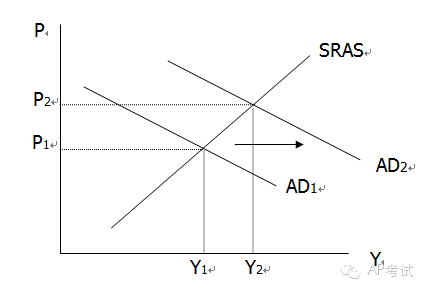 短期内,当总需求从AD1增加到AD2时,价格的上升伴随着产出的增加,而从生产函数的角度来看,产出的增加意味着投入的增加,短期内产出的增加只能靠劳动投入的增加来实现,这就意味着失业率的下降,通货膨胀率与失业率的这种反向变动的关系,就称为短期菲利普斯曲线。
短期内,当总需求从AD1增加到AD2时,价格的上升伴随着产出的增加,而从生产函数的角度来看,产出的增加意味着投入的增加,短期内产出的增加只能靠劳动投入的增加来实现,这就意味着失业率的下降,通货膨胀率与失业率的这种反向变动的关系,就称为短期菲利普斯曲线。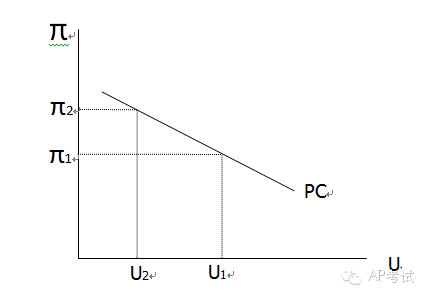 长期时,当总需求从AD1增加到AD2时,仅仅是价格水平的上涨,而没有产量的增加,这时通货膨胀与失业率无关,失业率固定在一个水平,这是长期菲利普斯曲线。
长期时,当总需求从AD1增加到AD2时,仅仅是价格水平的上涨,而没有产量的增加,这时通货膨胀与失业率无关,失业率固定在一个水平,这是长期菲利普斯曲线。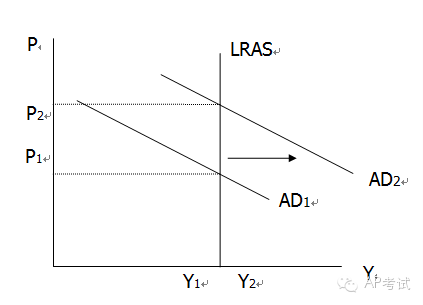
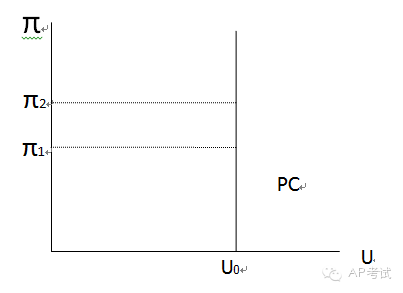 当然,菲利普斯曲线也可以有总供给曲线推导出来,过程与上面相仿,只是去掉总需求曲线。
当然,菲利普斯曲线也可以有总供给曲线推导出来,过程与上面相仿,只是去掉总需求曲线。
预期的影响:
带有预期通货膨胀的菲利普斯曲线为:π=πe-k(U-Un) 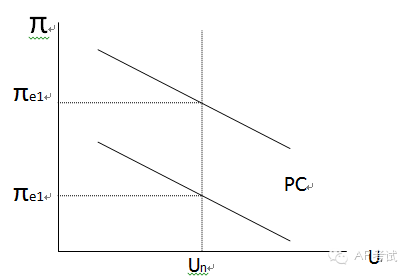 预期的不同,会导致菲利普斯曲线沿着自然失业率移动。
预期的不同,会导致菲利普斯曲线沿着自然失业率移动。
VI. Economic Growth and Productivity (5–10%) 经济增长与生产率
A. Investment in human capital 人力资本投资
B. Investment in physical capital 物质资本投资
C. Research and development, and technological progress 研发与技术进步
D. Growth policy
增长政策
1.物质资本用于生产物品与劳务的设备和建筑物的存量。简单理解,也就是生产中的机器设备,比如车床、斧子、锤子等等。
2.人力资本工人通过教育、培训和经验而获得的知识与技能。主要指教育对劳动力素质的改进。
3.研发与技术进步经济的长期增长来源于技术进步,这是制定长期政策的出发点,因此,各国经济学家都试图说服政府将政策向研发部门倾斜,同时,实力雄厚的大型公司也会将资金的一部分投向研发部门,这是竞争导致的。市场会导致竞争、竞争会促使企业研发新技术,进而又会导致竞争。
4.增长政策对如何促进经济长期稳定的增长,当下并没有一致的看法,但大体说来,有如下几种:
一是通过改变储蓄率来影响储蓄,从而促进资本积累;
二是政府应该加强基础设置建设,降低市场运行的成本;
三是鼓励技术进步。补充一个关于生产函数的知识:Y=AF(K,L,H,N)Y代表产出,A代表技术水平,K代表物质资本量,L代表劳动力,H代表人力资本量,N代表自然资源。产出是这些变量的增函数,该函数有个性质,就是K,L,H,N同时翻倍,那么产出Y也将翻倍,写出来就是x Y=AF(xK,xL,xH,xN),这个性质叫做规模收益不变,即投入同时扩大x倍,产出也会扩大x倍,依据是现实中企业可以通过复制现有的生产来达到扩大产出的目的。
Open Economy: InternationalTrade and Finance VII. Open Economy:International Trade and Finance (10–15%) 开放经济,国际贸易与国际金融(资本)
A. Balance of payments accounts 国际贸易收支账户
1. Balance of trade 贸易平衡
2. Current account 经常账户
3. Capital account 资本账户
B. Foreign exchange market 外汇市场
1. Demand for and supply of foreign exchange 外汇的供求
2. Exchange rate determination 汇率
3. Currency appreciation and depreciation 货币升值与贬值
C. Net exports and capital flows 净出口与资本流动
D. Links to financial and goods markets 资本市场与产品市场的关系
A
1.国际贸易收支账户国际贸易收支账户:指记录、分类、整理一个国家或地区在一定时期里(通常为一年)所有的国际经济交易,用来表示这个国家对外经济的全部情况。包括经常账户、资本(金融)账户、错误和遗漏账户。
2.贸易平衡出口:在国内生产而销往国外的物品与劳务进口:在国外生产而销往国内的物品与劳务净出口=出口-进口,当这项为零时,就称为贸易平衡。
3.经常账户经常账户:是国际贸易收支账户中最基本的项目,凡是涉及经济价值以及居民和非居民之间的所有交易(不包括金融项目的交易)都包括在经常项目下。
4.资本(金融)账户资本(金融)账户:它记录的是资本所有权在国际间流动的交易。
B
1、不同国家使用不同的货币,不同货币间交换的比率就称为汇率。比如1美元兑换6人民币,1人民币兑换14日元。
汇率体现了一个国家货币的价格,当1人民币兑换10日元,变到14日元时,我们说人民币升值了,或日元贬值了。
2、当净出口为正时,意味着出口大于进口,这样本国就持有更多的外国货币,即本国的货物流出,国外的货币流入。
3、决定一个国家货币价值的主要因素是这个国家商品的受欢迎程度,当一国的商品受欢迎时,世界各国纷纷来该国采购,从而导致对该国货币的需求增加,从而货币升值,反之若该国商品不受欢迎则货币会相应贬值。
翰林AP课程具备学校资质 可提供AP成绩认证+学分认证
扫码添加翰林小助手 一对一咨询


最新发布
© 2025. All Rights Reserved. 沪ICP备2023009024号-1









